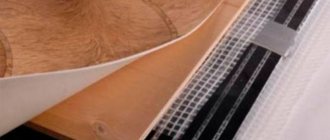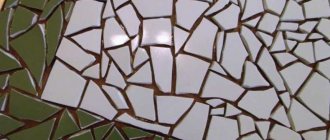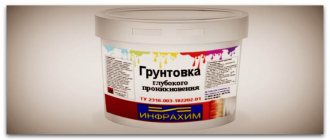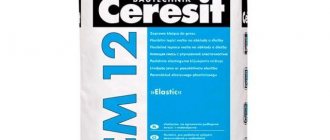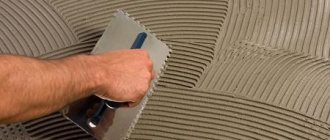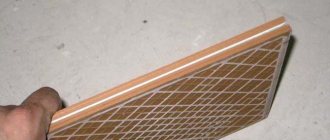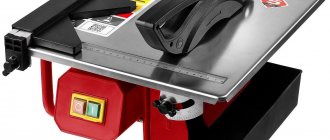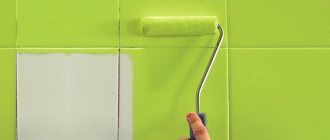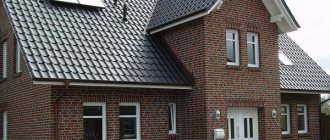Types of ceramic tiles Types of ceramic tiles Classes of ceramic tiles Characteristics of ceramic tiles
It’s rare that a modern interior is complete without decorating it with tiles. This is not only an amazing material with a wide list of characteristics, but also a stunning decor that can gracefully decorate any interior. A wide selection of tiles allows designers to embody the most daring ideas. This material is appropriate in any area - on the floor, wall, stairs, etc. Let's take a closer look at what types and types of tiles there are, as well as what technical characteristics they have.
Matte porcelain tile Salt-Pepper (Gres) from the Cersanit factory is a good solution for rooms with a high level of traffic.
Introduction
Ceramic tiles have been used since the 2nd-3rd millennium BC. During its use, this finishing material has received many types and forms. If you are going to do renovations and want to understand which tiles are right for you, it is worth getting an idea of all types of ceramic tiles. This article will help you understand veneer ceramics and find out by what criteria they are divided.
Ceramic tiles are flat ceramic products for facing work. This finishing product is made from mixtures of different types of clay with the inclusion of additional natural components. The initial mixture is pressed under high pressure and fired at temperatures ranging from 1040 to 1300 degrees , depending on the type of ceramic. Ceramic tiles are also called “tiles” .
Ceramic slabs are divided according to the following criteria:
· By type of production · By purpose · By surface type · By abrasion class · By porosity and water absorption · By friction coefficient value · By grade · By shape and size
Porcelain tiles (Gres)
Porcelain tiles are several times superior to traditional types of ceramic tiles, as well as marble and granite in terms of performance characteristics. It is produced using a more complex and advanced technology than standard ceramics, but the result is a truly durable, high-strength material with high wear resistance and immunity to temperatures, precipitation, and mechanical stress.
If previously such material was considered expensive (it was brought mainly from Italy), now porcelain stoneware is affordable thanks to well-established production in Russia. Ceramic granite looks very presentable - thanks to modern pattern application technology, it is possible to create any tile design. More details in the article - types of porcelain stoneware.
Classification of ceramic tiles depending on the type of production
The manufacturing method is the main criterion for the classification of facing slabs. Thus, during production, slabs differ in the method of molding and the number of firing stages. There are 2 methods of shaping slabs:
· Pressing – processing materials by pressure to change properties. · Extrusion – extrusion of clay mass through a molding hole.
Initially, they also used a method such as casting. Today, casting is not used in the production of facing ceramics. Sometimes this method is used to a limited extent because production this method costs more.
By type of production there are:
1. Monocottura 2. Bicottura 3. Majolica 4. Faience 5. Monoporosa 6. Cotto 7. Cottoforte 8. Clinker 9. Porcelain stoneware
Each type of ceramic product has its own characteristics and scope of application.
- Monocottura – translated from Italian mono – one, cottura – firing. This type of tile is distinguished by single firing technology. Here the base of the slab and the enamel are fired simultaneously. This type of cladding is used for floors and walls. This ceramic is characterized by high density and low water absorption - less than 3%. The base of the slabs is up to 6 mm thick. Frost-resistant types of monocottura are suitable for finishing unheated rooms and for exterior decoration.
- Bicottura These are double-fired ceramic products. The base of the slab is fired for the first time. The base is also referred to as “biscuit”. Before this, the blank for such tiles is pressed with a pressure of 250-300 kg/cm2. The temperature indicators of the first firing are 1120-1150 degrees C. After the first firing, a layer of glaze is applied to the surface of the slab and sent for the second firing. With this “glaze” firing, the temperature is 1060-1100 degrees. Double fired tiles are not as durable as monocottura. It is used for finishing walls indoors. However, the glazed surface perfectly withstands the effects of chemicals and household ceramic care products. Bicottura is produced in collections with a large range of decorative elements.
- Majolica is a ceramic facing slab with a porous structure, produced by double firing. A color image is applied to the opaque enamel of such plates. Water absorption rates range between 15 – 25%. The variety of decorative patterns makes this type of ceramic a popular finishing element. Suitable for decorative purposes for interior decoration outside wet areas. Used in classic style design. Panels are formed from majolica, walls are decorated with it, and stoves are decorated with it.
- Faience – is also called white ceramics because it contains high-quality white clay. Such tiles are produced by double firing, resulting in a water absorption level of 10 to 20%. Used in interior finishing works, in rooms with moderate humidity.
Atlas - Monoporosa – single-fired ceramics. In this respect, this type is similar to monocottura, but differs in the composition of the mixture. Here white clay with the presence of carbonates is added. This ceramic product is less durable than monocottura, with a porous composition and a water absorption coefficient of 15%. To add strength, manufacturers produce such facing ceramics with an increased thickness of up to 12 mm. The coating in the form of a thin layer of enamel allows you to reproduce a marble or wood surface. Suitable only for interior finishing work for gluing to the wall. Such tiles are cheaper and quickly set with an adhesive.
- Cotto – this version of ceramic finishing is made from red clay, but no glaze is applied. Cotto is made by extrusion with one-time firing at a temperature of 1100 degrees. The surface of this tile is rough due to processing with special brushes. Porosity and moisture absorption depend on the characteristics of production; the moisture absorption coefficient ranges between 3 and 15%. Cotto ceramic cladding began to be produced in Florence in the 17th century for covering church floors. This type of facing ceramics is produced in a variety of shapes and sizes - from ordinary round and rectangular slabs to storm drains in spatial formats. This type of ceramic is used for tiling work inside rooms and outside in outdoor conditions at different temperatures.
- Cottoforte - here the composition contains more than one type of clay. This improves the strength and durability of such ceramic cladding. A layer of glaze gives this tile an aesthetic appearance. Double firing is used for production. This tile is stronger than majolica, which is why cottoforte is used for flooring. The water absorption coefficient is 7-15%, which is why it is only suitable for dry interior spaces.
- Clinker – such material is made from refractory shale clay using the extrusion method, that is, extrusion. Fired at a temperature of 1300 degrees. The rough surface of clinker does not slip. Due to their improved strength characteristics, clinker tiles are used in cladding facades, fences and stair steps.
- Porcelain tiles - a type of high-strength slabs, which, unlike clinker, are produced by molding and pressing. Another name for this material "artificial granite". Produced by semi-dry pressing with a pressure of 500 kg/cm2 followed by a single firing. It can be glazed and painted in mass. In terms of strength, ceramic granite is compared only with natural types of stone, which ceramic granite surpasses in this indicator. At the same time, porcelain stoneware does not absorb moisture, is fireproof, frost-resistant, resistant to chemical attack, easy to clean and does not require special care. Porcelain tiles imitate both natural types of stone - marble, granite, onyx, as well as concrete, wood and designer surfaces.
Goldy
This material is universal in application. It is used for finishing indoors and outdoors. Porcelain tiles are suitable for installation on walls, floors and even ceilings. Furniture, window sills, and kitchen aprons are made from porcelain stoneware. This material is used to cover fireplaces and areas near swimming pools, as well as areas of shopping centers and industrial premises. This material is more expensive than ceramic tiles, but also lasts for decades. They also produce collections that combine porcelain tiles and tiles.
3D panels
Three-dimensional panels are large tiles and slabs with a relief pattern. Attach the panels to an adhesive solution or to the lathing.
Plaster 3 D
panel “Tooth” 500x500.
Gypsum 3D panel “Zuben” 500x500
In the first case, the surface requirements and laying technology are the same as for conventional tiles. 3D panels are used exclusively as an element of interior decor. The relief can be anything: imitation of the texture of traditional finishing materials, geometric patterns, three-dimensional drawings in an abstract style.
The most common material is gypsum. But unlike artificial stone, 3D panels are often produced not painted, but in a basic white color.
Types of ceramic tiles by purpose and operating conditions
Country
Ceramic slabs are also divided according to their purpose into the following types:
- For finishing floors in the bathroom, kitchen, living room, hall, offices, retail premises
- For finishing walls in residential premises and public buildings.
- For finishing the facades of houses, balconies, stairs, terraces, street paths, local areas under the influence of weather conditions.
- For finishing surfaces exposed to high temperatures, such as heated floors, fireplace areas, baths, saunas.
For slabs used in exterior finishing, the following indicators are important:
· moisture absorption, · frost resistance, · heat resistance · fire safety
Titan
The scope of application of facing slabs, as well as the main characteristics, are indicated on the packaging in the form of inscriptions or pictograms.
Ceramic products for floor cladding are marked with shoe soles. for floor tiles :
· Abrasion class · Moisture absorption · Anti-slip level
wall decorations are marked with a hand marking. When choosing, the following parameters play a role:
· Abrasion class · Moisture absorption
External cladding works
Since the outer cladding is constantly exposed to such destructive factors as weather, it must be especially strong, frost-resistant and resistant to atmospheric conditions.
Roads and garden paths should be covered with particularly heavy stone (including artificial stone) or ceramics. At the same time, not all ceramics are suitable for paving, but only those with a strong structure. The tile material must have a high coefficient of friction and resistance to painting.
Decorating a house with facade tiles on a frame
If there is a need to insulate the masonry walls of the house or they are old and uneven, then you will need to attach a frame made of wood or a metal profile to the walls . Using a level, it is necessary to mount vertical and horizontal frames, between which you can install insulation with film, and attach hanging cladding systems connected by several parts on top.
Thus, there is a “dry” installation of screws or dowels, the result is a ventilated facade - the work is clean and fast. Installation starts from the corner, it looks and is fixed like siding - the plates are easily installed on top of each other, the odd tiles are cut to size and also secured with screws.
You can install the tiles directly onto the cement-based mortar over the insulation, but this process is more expensive and time-consuming.
Difference between tiles by surface type
Ceramic slabs are divided into glazed and unglazed. In glazed ceramics, a layer of glassy enamel is applied to the slab shard. This protective layer is called “glaze”. Enamel is made from the natural components of quartz, feldspars, and kaolins. Glazed ceramics are easy to clean, protect against moisture, and come in a wide variety of colors and decors. At the same time, unglazed ceramic products are more durable, but their colors are limited by the color of the clay from which they are made.
Glazed slabs have the following surfaces:
- Glossy and polished
- Matte
- Lapped
- Satin
- Embossed or structured
The glossy surface of the tile is the most aesthetically pleasing. It reflects light, making the room spacious and bright. For porcelain stoneware, this surface is called “polished” . During production, part of the glaze is cut off from a porcelain stoneware slab and polished to a shine. Such coatings are suitable for floors and walls. When using a polished floor surface in a damp room, such as a sauna or bathroom, it is better to lay a rubber mat near the bathtub or shower for safety.
Torso Bianco
Matte glaze is produced with a rough surface, so this coating is ideal for floors. Laying cladding with such a surface on walls can be no less effective. If you follow the advice of experts, slabs with a matte finish will turn out to be an ideal facing material. Finishing products with a matte finish are durable and wear-resistant. Although this coating looks discreet, with the help of such slabs you can create spectacular interiors. In rooms where slabs with a matte glaze are used, this surface creates a background for furniture and bright interior accents. So, in the kitchen, against the background of dark matte floor slabs, a kitchen set in brighter or lighter colors looks great.
The lappatted surface of the ceramic partly resembles a worn one. This type of glazed finish is also called "semi-polished" . Here, glossy and matte finishes are combined within one slab. Such ceramics also slip less and create stylish, solid interiors.
The satin surface of tile ceramics and porcelain stoneware is considered an unusual design surface. Here, during production, a coating of mineral salts is used before the firing process. The result is a surface that feels like velvet. On such slabs you will see an interesting play of light. In the interior, such a surface works great when creating exquisite, noble designs.
Shade
Ceramic products with a relief structure realistically imitate the surfaces of other materials, such as wood or natural stone. At the same time, when you run your hand over such slabs, you feel the uneven surface of the wood or the grooves and depressions of the marble covering. Moreover, porcelain tiles with the structural surface of wooden parquet are indistinguishable from real wood. Most types of tiles are produced with either a glossy or matte surface. The relief structured surface has also become widespread. The presence of all types of such surfaces is presented only in porcelain stoneware.
Mosaic
There are three ways to make mosaic panels:
- Classical or “Roman mosaic”. This is an original work in which the master creates an artistic composition from small elements of different sizes and colors. And the smaller the element, the more accurate the detailing of the drawing.
Robotic mosaic made to order. The mosaic panel is made at the factory using robotic systems based on a picture or photograph of the client. The complex consists of three units: a hopper with checks (matrices), an orientator and a robot for setting a pattern on a sticky base. - Finished mosaic from the catalog. The catalog image is divided into sections of standard sizes. All receipts of each matrix on the front side of the image are sealed with paper. At the site, the master assembles panels from individual matrices, gluing each fragment in its place onto a prepared base. Then he moistens the paper, removes it from the front layer, and seals the seams.
Glass mosaic coffee Mix - Mosaics can be made from different materials: stone or ceramic tiles, metal chips (polished or with an engraved design), glass or smalt. There are also types of glass mosaics interspersed with semi-precious stones, foil petals or threads of precious metals.
Instructions for laying decorative brick-like tiles on the wall:
Subscribe
Classification of ceramic tiles depending on abrasion class
The abrasion class of tiles or the wear resistance class of glazed ceramics is determined by one of 5 PEI groups according to the international standard EN ISO 10545.7 . PEI is an acronym for the American Ceramic Materials Research and Testing Institute. The tiles are assigned the appropriate class based on the results of the experiments. To do this, the surface of the facing material is exposed to an abrasive that imitates the action of the soles of human shoes. Each class shows in which rooms such cladding products should be used.
Metallica
Characteristics of abrasion classes:
- PEI 1 – these are rooms with a minimum amount of movement, where people walk barefoot or wear slippers, such as a bathroom, toilet
- PEI 2 – for rooms in the house where slippers are also worn. This includes kitchens and bedrooms. This class is not intended for use in kitchens, hallways and corridors.
- PEI 3 – premises with average traffic, mainly not in street shoes, but in house shoes. Suitable for residential premises, hotels, offices with a small flow of people.
- PEI 4 - this class includes places with medium traffic intensity with a transition to active traffic. Interiors of the residential sector, offices, shopping centers, cafes, restaurants, hotels are suitable here.
- PEI 5 - this abrasion class characterizes the most durable slabs that are suitable for any room. This also includes public places with high traffic, such as large shopping centers, airports, and train stations.
Tiles depending on porosity and water absorption
The porosity of a slab is determined by the microscopic voids within its structure. This characteristic directly affects water absorption. The greater the porosity, the more moisture remains in the slab. At the same time, water absorption affects the technical and operational characteristics of the finishing material. This is because porosity and water absorption reduce surface hardness, flexural strength and frost resistance. These parameters narrow the scope of use of the material.
Blanco
The moisture resistance of ceramics is regulated by the European standard EN ISO 10545-3 . According to this standard, experiments are carried out with moisture entering the pores of slab samples. Based on the results of the experiments, 3 levels of water absorption of tile cladding are distinguished:
1. Low level - less than 3% 2. Average level - from 3 to 10% 3. High water absorption - more than 10%
Low water absorption is characteristic primarily of porcelain stoneware. For porcelain stoneware slabs these values are 0.05%.
Classification depending on friction coefficient
The anti-slip level of floor tile products is determined by the friction coefficient R. This is a European standard, which is formed based on the results of practical experiments. The number next to the letter R determines in which zone such a facing surface is used. R9 – This includes entrance areas, trading floors, corridors, halls, stairs, food outlets, pharmacies, hospitals, laboratories, hairdressers, dry cleaners. R10 – Places with street trading, warehouses with food products, open warehouses, kitchens in public catering establishments, walkways and toilets.
Iceberg
R11 – Places where foods with vegetable fats are stored, produced and packaged, juices, meat processing, garages where moisture may enter, dyeing shops, and laundries. R12 - Areas for the production of dairy products, vegetable and animal oils, loading platforms, parking lots for fire service vehicles, gas stations at enterprises. R13 – Special purpose areas at industrial enterprises.
Types of tiles
The grade of ceramic products is determined by the international type standard EN98 . According to the standard, finishing materials are divided into 3 grades:
- First grade
- Second grade
- Third Grade
The first grade allows no more than 5% of ceramic tiles in one batch with minor deviations.
However, according to GOST the following defects are unacceptable:
· Notches on the front surface of the ribs · Defects on the front sides · Spots · Bubbles and waves in the glazed surface · Other defects
The curvature of the surface of the first grade slabs does not exceed 0.5% of the length of one side. Dimensions must comply with the tolerance in the form of gauge.
second grade
ceramics, no more than 25% are allowed . Here, no more than 2 chips are allowed on the front side of the surface. The size of such defects should not exceed 2 mm. Notches along the edges of the slabs in width and length are no more than 1 and 10 mm, respectively. The presence of spots, bubbles and waves on the surface of the glaze is also acceptable. Possible disturbance in color intensity. In such a batch, the tiles may also differ in tone.
The third grade according to the standards implies more than 25% of defective tiles. The third grade is practically never found in stores. Most of the ceramic products on the Russian market are first grade. If you are going to buy a second grade tile, be sure to check its caliber. This indicator is important during installation.
Tile shape and size
As it existed, tile ceramics acquired more and more diverse forms. This circumstance opened up a wide scope for creativity for designers and allowed them to create unique, expressive interiors.
The shapes of ceramic slabs are divided into 3 types :
1. Square 2. Rectangle 3. Non-traditional shapes
Square and rectangular slabs are the most popular. Among the non-traditional geometric shapes, ceramics are triangular, round, diamond-shaped, six- or eight-corner. The use of slabs with different shapes makes it possible to diversify the design of the room as much as possible. Also, small-format tiles of the “hog” . These rectangular slabs resemble brickwork and are often used in the kitchen. They perfectly complement interiors in modern styles, such as loft, scandi or art deco.
Amber
The dimensions of finishing ceramics depend on its purpose. Please ensure that the surfaces for laying tiles are multiples of its dimensions. Then you will be able to more accurately calculate the required number of tiles and reduce the amount of leftovers when trimming. This will save your money.
All ceramic finishing according to size categories is divided into 3 groups: 1. Small format - decors and mosaics up to 5x5 cm 2. Medium format - side sizes range from 10 to 50 cm 3. Large format - sides with sizes from 50 to 120 cm
The correctly selected dimensions of the slabs also determine how harmoniously the ceramics will combine with the rest of the interior details. At the same time, the size of the tile affects the ease and convenience of installation.
Breach Silver
Please note that large slabs are easier and faster to install. When using this format, the number of seams is reduced. As a result, the space with such cladding looks beautiful and monolithic. For walls, slab thicknesses of 3 mm or more . The floor type of ceramics must withstand heavy loads, so here the thickness starts from 5-6 mm . We also note that ceramic flooring is suitable for installation on a wall. But it is better not to lay wall slabs on the floor, due to their smaller thickness and abrasion resistance.
Results
Among all kinds of wall finishing materials, ceramic tiles stand out separately, which can easily be glued to any wall. In addition, ceramic coating is a durable material.
Due to the wide selection of tiles in modern construction stores, you can choose exactly what the home owner wants. Ceramic wall covering is one of the best facing materials, which has a number of advantages such as: durability, resistance to scratches and damage, and ease of cleaning from dirt.
